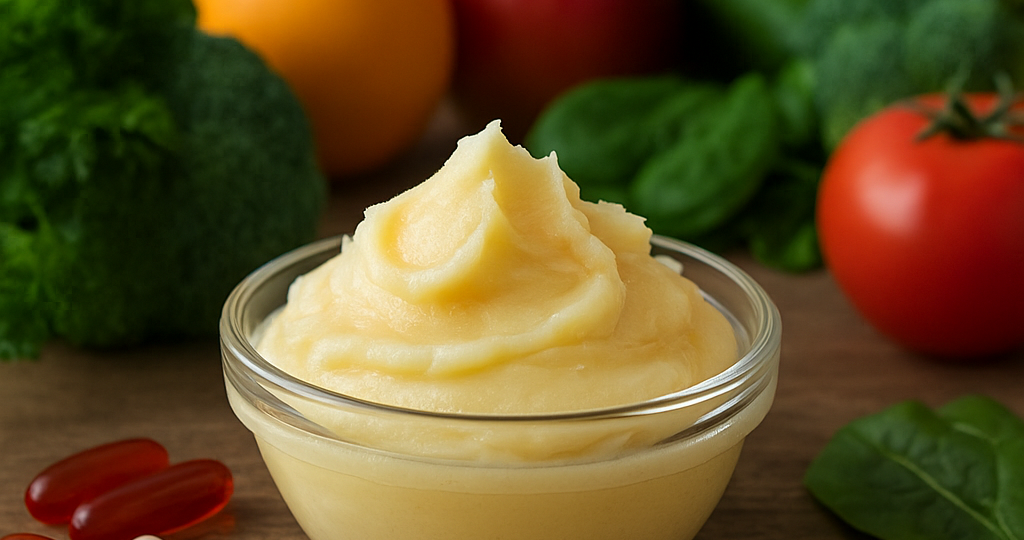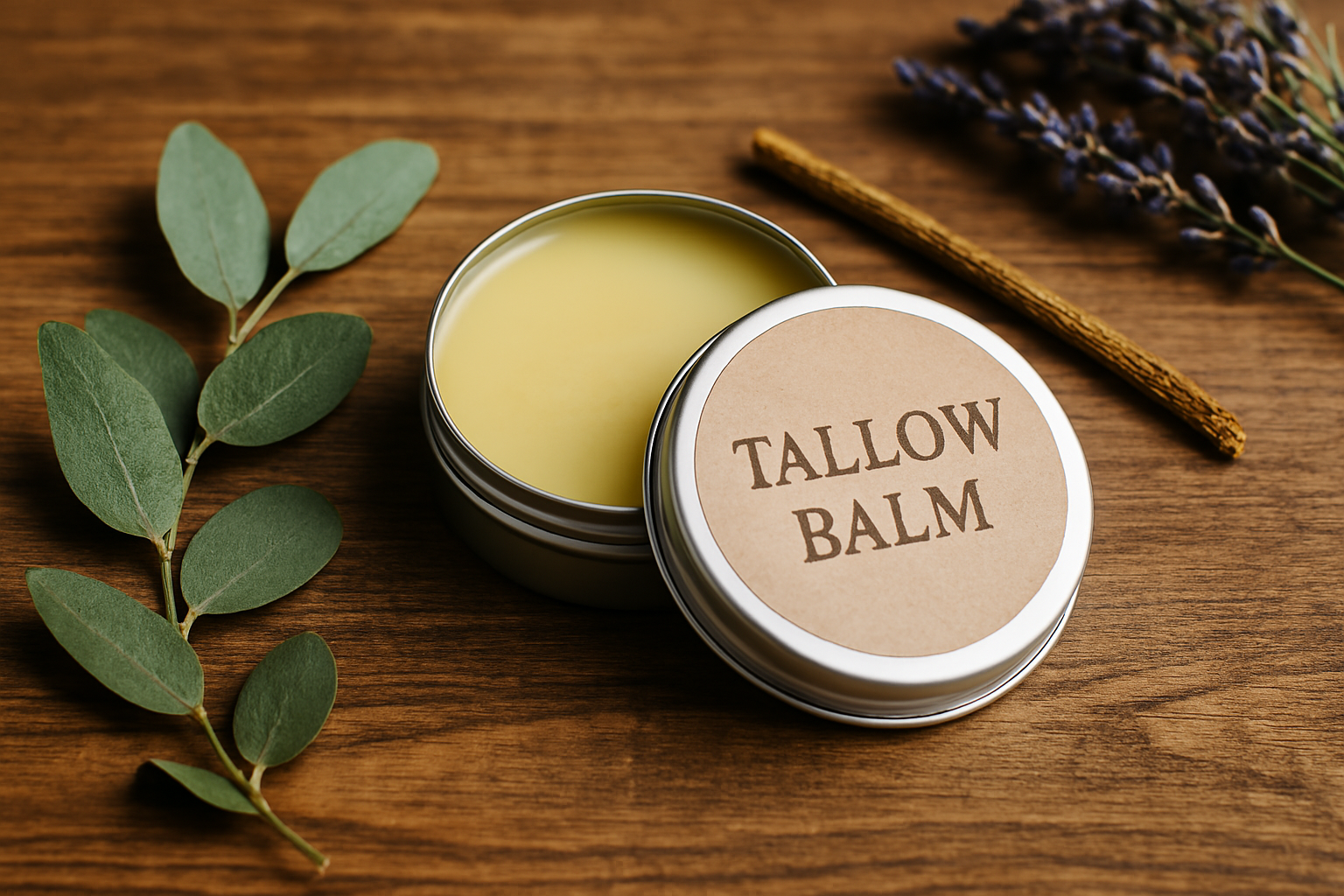Can Tallow Improve Gut Health? Essential Fats That Support Digestion Naturally
May 6, 2025 | by iprittie@gmail.com

Looking for gut-friendly cooking fats?
Beef tallow, a traditional cooking fat that has fallen out of favor in modern times, is making a surprising comeback in health circles – particularly for its connection to gut health. Many people may not realize that this rendered fat from cattle contains specific fatty acids that interact with our digestive system in beneficial ways. Beef tallow contains saturated fats that can actually support gut health by maintaining the integrity of the intestinal lining and providing fuel for beneficial gut bacteria.

The relationship between tallow and digestion goes beyond just providing energy. Tallow is rich in fat-soluble vitamins that support various bodily functions, including immune health. When sourced from grass-fed animals, tallow provides an even more impressive nutritional profile with antioxidants and healthy fats that may help reduce inflammation in the digestive tract.
Contrary to its reputation as merely a cooking fat, beef tallow has properties that can boost the digestive system. The specific fatty acid composition creates an environment that supports beneficial bacteria while helping to maintain proper barrier function in the gut lining. This relationship between traditional animal fats and digestive health represents an interesting intersection of ancestral wisdom and modern nutritional science.
Key Takeaways
- Beef tallow contains specific fatty acids that support gut barrier function and provide fuel for beneficial bacteria.
- The fat-soluble vitamins in tallow contribute to immune function and overall digestive health.
- Grass-fed tallow offers enhanced nutritional benefits including anti-inflammatory properties that may improve gut health.
What Is Tallow and Its Traditional Uses

Tallow is a solid, shelf-stable fat derived from rendering the tissues of animals like cattle or sheep. This nutrient-dense substance has been used across cultures for centuries in cooking, skincare, and household applications. Its use gives us an important glimpse into ancestral gut health practices.
The Composition of Tallow
Beef tallow consists primarily of saturated and monounsaturated fats. It contains approximately 50% saturated fat, 42% monounsaturated fat (primarily oleic acid), and about 4% polyunsaturated fat.
Tallow is rich in fat-soluble nutrients including:
- Vitamin A (supports vision and immune function)
- Vitamin D (essential for bone health)
- Vitamin E (antioxidant properties)
- Vitamin K (aids in blood clotting)
These essential vitamins make tallow more than just a cooking fat. When sourced from grass-fed animals, tallow contains higher concentrations of omega-3 fatty acids and conjugated linoleic acid (CLA).
Historical Perspectives on Tallow
Historically, tallow was a kitchen staple before the rise of vegetable oils. Native Americans used every part of buffalo and cattle, including rendering fat for cooking and preservation.
In European traditions, tallow candles provided light for centuries before electricity. Soap-making relied heavily on tallow, with traditional tallow soaps prized for their skin-friendly properties.
Many dermatologists now recognize tallow’s similarity to human sebum, making it effective for skincare. The substance contains stearic acid and palmitic acid, which help maintain skin barrier function.
Traditional medicine in various cultures used tallow as a salve for wounds, burns, and dry skin conditions before modern pharmaceuticals.
Comparative Analysis of Fats and Oils

Different dietary fats have unique effects on our health, especially when it comes to gut function and overall wellness. These differences stem from their chemical structures and how our bodies process them.
Tallow Versus Plant-based Oils
Tallow is a nutrient-dense animal fat that offers different properties than plant oils. Beef tallow contains essential fat-soluble vitamins that support hormone production and cell membrane integrity. It has a high smoke point, making it stable for cooking at high temperatures.
In contrast, plant oils like soybean oil, corn oil, and olive oil have different properties. Olive oil is prized for its monounsaturated fat content and antioxidants. However, highly processed oils such as soybean and corn oils contain higher levels of polyunsaturated fatty acids (PUFAs).
Research indicates that different dietary fats can affect gut microbiota differently. High-fat diets using different oils show varying impacts on lipid metabolism, oxidative stress, and gut bacteria.
Saturated and Unsaturated Fat Content
The fat composition in different oils significantly impacts how they affect our bodies. Here are some guidelines as to animal fat vs plant oil digestion:
| Fat Type | Saturated Fat | Monounsaturated Fat | Polyunsaturated Fat |
|---|---|---|---|
| Beef Tallow | High | Moderate | Low |
| Olive Oil | Low | High | Low |
| Soybean Oil | Low | Moderate | High |
| Corn Oil | Low | Moderate | High |
Saturated fats in tallow remain stable during heating, while polyunsaturated fats in plant oils can oxidize more easily. This oxidation may contribute to inflammation and gut barrier dysfunction.
Studies show that the source of dietary fat significantly affects blood lipids, including triglycerides and cholesterol levels. Nuts, which contain primarily unsaturated fats, tend to improve cholesterol profiles when substituted for saturated fats.
Gut Health Basics

Your gut contains trillions of microorganisms that influence everything from digestion to immune function. The balance of these tiny inhabitants plays a crucial role in overall health and can be significantly affected by what you eat.
Understanding the Gut Microbiome
The gut microbiome refers to the vast community of bacteria, viruses, fungi, and other microorganisms living in your digestive tract. Most of these microbes reside in your large intestine.
An adult human typically hosts around 38 trillion microbes, with over 1,000 different species of bacteria alone. These microorganisms aren’t just passive residents—they help digest food, produce vitamins, and protect against harmful pathogens.
The gut microbiota composition varies widely between individuals based on genetics, age, environment, and lifestyle factors. Scientists now consider the gut microbiome so important it’s sometimes called the “forgotten organ.”
A healthy microbiome shows high diversity and a balance between beneficial and potentially harmful microbes. When this balance is disrupted (dysbiosis), various health problems can develop.
Role of Diet in Gut Microbial Balance
What you eat directly influences which microbes thrive in your gut. Different bacteria feed on different nutrients, so your dietary intake strongly shapes your microbial community.
Fiber-rich foods like fruits, vegetables, and whole grains feed beneficial bacteria that produce short-chain fatty acids, which nourish gut cells and reduce inflammation.
Conversely, diets high in processed foods and certain animal fats may alter gut microbiota composition in less favorable ways. These dietary patterns can increase gut permeability and inflammation.
Fermented foods like yogurt, kimchi, and sauerkraut introduce beneficial live bacteria directly into your digestive system. These probiotic foods can help maintain microbial diversity.
Prebiotic foods containing specific types of fiber nourish existing good bacteria, promoting their growth and activity in the gut.
Tallow’s Impact on Gut Microbiota

Dietary fats like tallow can significantly influence the composition and function of gut microbes. As one of the healthiest fats for microbiome balance, more and more positive research on tallow is emerging. Research shows that the type of fat consumed affects microbial populations and their metabolic activities in the intestinal environment.
Influence of Tallow on Microbial Diversity
Tallow consumption may alter the balance between key bacterial phyla in the gut. Studies examining dietary fat influence on gut microbiome show that animal fats can shift the ratio between Firmicutes and Bacteroidetes, two dominant bacterial groups in the intestinal tract.
Tallow, being a saturated animal fat, typically:
- Provides a different substrate for bacterial metabolism compared to plant oils
- May support certain beneficial bacteria that thrive in the presence of specific fatty acids
- Contains fat-soluble vitamins that indirectly support gut health
Grass-fed tallow specifically contains higher levels of conjugated linoleic acid (CLA), which some research suggests may promote beneficial bacteria growth. As an anti-inflammatory cooking fat, the health benefits of grass-fed tallow extend beyond just providing energy.
Tallow Consumption and Dysbiosis
Excessive consumption of any dietary fat, including tallow, may contribute to gut microbiota dysbiosis—an imbalance in the microbial ecosystem. This disruption can potentially lead to intestinal inflammation and reduced barrier function.
The relationship between animal fats and intestinal microbiota reveals that the source and quality of fat matters significantly. High-quality tallow from grass-fed animals may have different effects than conventional sources.
Moderation appears key when incorporating tallow into the diet. Some evidence suggests that balanced consumption of various fats, rather than excessive amounts of any single type, supports optimal gut health and helps prevent dysbiosis.
Emerging research also indicates that the impact of dietary proteins and fats on gut microbiota varies based on individual factors such as existing microbiome composition and overall dietary patterns.
Health Implications of Fatty Acids in Tallow
Beef tallow contains different types of fatty acids that offer surprising benefits to both gut and overall health. These fatty acids work in different ways to support the body’s functions at both local and systemic levels.
Short Chain Fatty Acids and Gut Health
Beef tallow helps produce short chain fatty acids when metabolized in the digestive system. These compounds are crucial for maintaining a healthy gut lining and promoting beneficial bacteria growth.
The fatty acids in tallow help strengthen the intestinal barrier, reducing the risk of “leaky gut” issues. This protective effect comes from the way these fats support the cells that line the digestive tract.
Some components in beef tallow have antimicrobial properties that help balance gut flora. This can lead to better digestion and reduced inflammation in the intestines. As a saturated fat to support gut integrity, it makes sense to consider introducing tallow to the diet.
Studies suggest that the right balance of fatty acids supports the gut’s ability to extract nutrients from food. This improved efficiency makes tallow a functional food rather than just a cooking fat.
Long Chain Fatty Acids and Systemic Health
Beyond the gut, tallow contains long chain fatty acids that benefit the entire body. These include omega-3 and omega-6 fatty acids that play critical roles in reducing systemic inflammation.
Beef tallow contains fat-soluble vitamins that work alongside the fatty acids to support:
- Immune function
- Bone health
- Cellular repair
- Hormone production
The conjugated linoleic acid (CLA) in tallow has been linked to improved metabolic health. Research indicates it may help with fat metabolism and maintaining healthy body composition.
Properly sourced tallow contains docosahexaenoic acid (DHA) in small amounts, which supports brain health and cognitive function. Tallow cooking allows the consumption of short-chain fatty acid foods, which makes quality tallow a multifunctional food that benefits both digestion and neurological health.
Metabolic Diseases and the Role of Dietary Fats
The types of fats we consume can significantly impact our metabolic health. Dietary fats influence our gut microbiota, which plays a crucial role in how our bodies process nutrients and manage inflammation.
The Connection Between Diet and Type 2 Diabetes
Type 2 diabetes develops when the body becomes resistant to insulin or doesn’t produce enough insulin. Dietary lipids affect lipid metabolism and blood lipid levels, potentially contributing to insulin resistance.
Animal fats like tallow contain saturated fats that may affect insulin sensitivity differently than plant-based oils. The quality of fat matters tremendously.
Studies show that gut bacteria respond differently to various fat types. When someone consumes high amounts of certain saturated fats, it can alter their gut microbiome composition, potentially promoting inflammation.
This inflammation creates a cycle that worsens insulin resistance. However, not all animal fats have the same effect. Tallow from grass-fed animals contains a different fatty acid profile than that from grain-fed animals.
Obesity and Fat Consumption
Obesity results from complex interactions between diet, lifestyle, and genetics. The source of dietary fat significantly affects body weight changes and triglyceride levels in the liver.
Not all fats contribute equally to weight gain. The quality and composition of dietary fats matter more than simply reducing all fat intake.
Fat consumption affects hunger hormones and satiety. Quality animal fats like tallow may help some people feel fuller longer than processed oils.
The gut microbiome plays a key role in how dietary fats are processed. Lipid-microbiota interactions influence metabolic health, potentially affecting whether consumed fats lead to weight gain or not.
Fat type affects bile acid production, which in turn influences gut bacteria composition. This can either promote or protect against diet-induced obesity and non-alcoholic fatty liver disease.
Immunological Effects of Tallow Consumption
Tallow consumption can influence immune system function through multiple pathways involving fatty acids and fat-soluble vitamins. These effects extend to both systemic inflammation and gut microbiome interactions.
Systemic Inflammation and Tallow
Tallow contains saturated fats that interact with the body’s inflammatory response in complex ways. Some research indicates that certain fatty acids in tallow may affect pro-inflammatory cytokines, which are signaling proteins that regulate inflammation.
The fat-soluble vitamins in tallow, especially vitamins A, D, and E, support immune function and may help maintain balanced inflammatory responses. Vitamin D is particularly important for immune regulation and modulating inflammatory pathways.
However, excessive consumption of saturated fats may potentially increase endotoxemia, a condition where bacterial toxins like lipopolysaccharide (LPS) enter the bloodstream. This can trigger inflammatory responses in susceptible individuals.
The quality of tallow matters significantly. Grass-fed sources typically contain more beneficial fatty acids compared to conventionally raised animal sources.
Gut Microbiome and Immune Function
Tallow contains butyric acid, a short-chain fatty acid that plays a crucial role in gut health. Butyric acid helps maintain intestinal barrier integrity, potentially reducing harmful bacteria translocation into the bloodstream.
The relationship between dietary fat and gut microbes influences overall immune function. Tallow’s specific fatty acid profile may support beneficial bacteria that produce anti-inflammatory compounds.
Gut barrier function is critical for preventing lipopolysaccharide from entering circulation. When the gut barrier weakens, these bacterial components can trigger systemic inflammation.
Research shows no clear evidence that animal fats like tallow have negative effects on gut microbiome when consumed as part of a balanced diet. The quantity and context of consumption appear more important than the fat itself.
Tallow and Cardiovascular Health
The relationship between tallow consumption and heart health involves several key factors related to its fat composition and how our bodies process these fats. Research shows mixed findings on tallow’s cardiovascular effects.
Curious how tallow supports more than digestion? Discover how traditional fats like tallow can impact heart health and cholesterol naturally.
Cholesterol, Tallow, and Heart Disease
Beef tallow contains high levels of saturated fat, which may raise concerns about heart health. Consuming foods high in saturated fat can increase your risk of coronary heart disease by elevating LDL (low-density lipoprotein) cholesterol levels.
Studies suggest that diets high in saturated fats like those found in tallow might contribute to atherosclerosis—the buildup of plaque in arteries. This plaque accumulation can restrict blood flow and potentially lead to serious cardiovascular events.
However, the picture isn’t entirely negative. Tallow also contains some stearic acid, a type of saturated fat that may have a more neutral effect on cholesterol levels compared to other saturated fats.
Comparisons with Other Fatty Acids
Tallow contains a mix of fatty acids, including approximately 45-50% saturated fat, 42-50% monounsaturated fat (primarily oleic acid), and small amounts of polyunsaturated fats.
Oleic acid, the predominant monounsaturated fat in tallow, is the same healthy fat found in olive oil. Some research suggests oleic acid may have potential benefits for heart health, though evidence remains inconclusive.
When compared to highly processed seed oils, tallow offers:
- Greater heat stability
- Lower levels of inflammatory omega-6 fatty acids
- No artificial additives or processing chemicals
However, plant-based oils like olive oil and avocado oil generally contain higher percentages of heart-healthy monounsaturated fats and less saturated fat than tallow, making them potentially better choices for cardiovascular health according to most experts.
Culinary Applications of Tallow
Tallow offers exceptional versatility in the kitchen with its high smoke point and distinctive flavor profile. This traditional cooking fat provides both practical advantages for various cooking methods and nutritional benefits that many modern oils lack.
Tallow in Cooking and Frying
Tallow excels as a cooking medium due to its remarkably high smoke point of approximately 400°F (204°C). This makes it ideal for high-temperature cooking methods like deep frying, sautéing, and roasting without breaking down or producing harmful compounds.
Many chefs prefer tallow for creating crispy, flavorful textures in foods. It works exceptionally well for:
- French fries and potato dishes
- Pan-searing meats
- Donuts and fritters
- Pastries and pie crusts
Unlike vegetable oils that can impart unwanted flavors, tallow adds a subtle richness that enhances rather than overwhelms dishes. Its solid consistency at room temperature also makes it perfect for creating flaky baked goods.
Traditional cultures have relied on tallow for centuries, appreciating its stability and resistance to rancidity. Modern restaurants are now rediscovering tallow as part of a return to heritage cooking methods.
Nutritional Benefits of Tallow in Recipes
Incorporating tallow into recipes provides more than just culinary advantages – it delivers significant nutritional value to a balanced dietary intake. As a natural fat for digestive support, tallow contains fat-soluble vitamins that support immune function and bone health.
The fatty acid profile of tallow includes:
| Fatty Acid Type | Approximate Percentage |
|---|---|
| Saturated | 50% |
| Monounsaturated | 42% |
| Polyunsaturated | 4% |
Tallow contains natural enzymes called lipases that aid in fat digestion and absorption. These enzymes can potentially support gut health and improve how the body processes fats.
While tallow’s saturated fat content has raised health concerns for some, others advocate for its place in a balanced high fat diet. The key is moderation and understanding how it fits within overall nutritional needs.
Tallow’s Role in the Host-Microbiome Axis
Tallow contributes to gut health through its unique fatty acid profile that influences how our body interacts with gut bacteria. The relationship between dietary fats like tallow and our microbiome affects both our digestive function and overall health.
Host-Microbiome Interactions and Metabolites
The gut microbiome plays a crucial role in processing dietary fats, including those found in tallow. When we consume tallow, its saturated fats interact with our gut bacteria in ways that can influence overall digestive function.
Studies have shown that dietary fat sources affect the composition and function of the intestinal microbiota. These interactions create metabolites that signal to various body systems.
Not all cooking fats treat your gut the same—see why seed oils and tallow affect microbiome health in very different ways.
The fatty acids in tallow can support the growth of certain beneficial bacteria. These bacteria then produce short-chain fatty acids (SCFAs) that nourish the cells lining the gastrointestinal tract.
Tallow’s conjugated linoleic acid (CLA) content may help maintain a balanced microbiome. This balance is essential for proper immune function and metabolism regulation.
Tallow-Derived Metabolites and Health
When gut bacteria process tallow’s fatty acids, they create metabolites that influence health beyond the digestive system. Research indicates that different animal fats affect energy efficiency and obesity development through these metabolic pathways.
Tallow contains fat-soluble vitamins A, D, E, and K that support immune function and bone health. These nutrients require proper fat digestion and absorption, processes mediated by the microbiome.
The CLA in tallow has been linked to supporting a healthy metabolism through interactions with gut bacteria. These bacteria transform CLA into compounds that may help with fat metabolism.
Some evidence suggests that the saturated fats in tallow may help maintain gut barrier integrity. This integrity prevents harmful substances from entering the bloodstream and triggering inflammation.
Modern Perspectives and Future Research
Recent scientific exploration has revealed promising connections between tallow consumption and digestive health. Researchers continue to investigate how this traditional fat might benefit modern health concerns, particularly related to gut function and associated metabolic conditions.
Current Trends in Tallow Research
Scientists are increasingly examining beef tallow’s impact on gut microbiota. Unlike processed fats with emulsifiers that can impair gut barrier function, natural animal fats may support microbial diversity.
Research suggests tallow’s fatty acid profile might reduce intestinal inflammation. This finding challenges decades of anti-saturated fat messaging and invites reconsideration of traditional fats.
Studies now explore how beef tallow interacts with the inherent flexibility of the human gut. The microbiome’s adaptability to various food sources, including animal fats, indicates evolutionary compatibility.
Researchers are investigating correlations between tallow consumption and insulin sensitivity. Preliminary data suggests certain fatty acids in tallow might help regulate insulin response, though more controlled studies are needed.
Potential Therapeutic Uses of Tallow
Emerging research examines beef tallow’s role in addressing specific health conditions. Its rich fat-soluble vitamin content may support immune function and overall gut health.
Some clinical investigations focus on tallow’s potential to reduce inflammation in digestive disorders. The specific fatty acid composition appears to modulate inflammatory pathways in intestinal tissues.
Researchers are exploring connections between tallow consumption and cancer prevention. While preliminary, some studies suggest certain fatty acids might inhibit cancer cell proliferation, particularly in digestive tract cancers.
Insulin resistance research shows promise regarding beef tallow’s possible metabolic benefits. Unlike processed vegetable oils, tallow’s stable structure may reduce oxidative stress affecting insulin signaling pathways.
RELATED POSTS
View all



